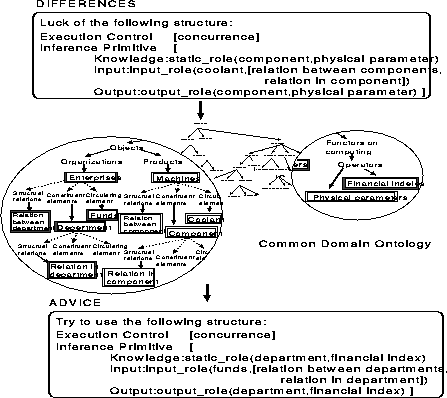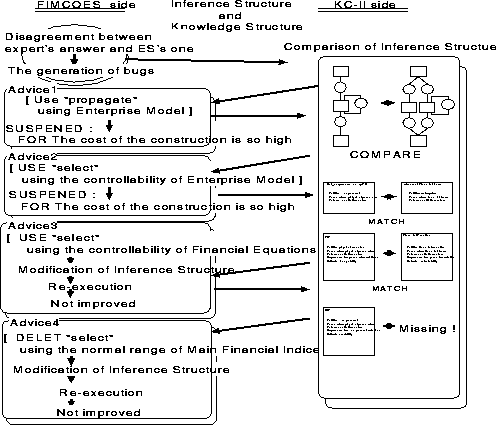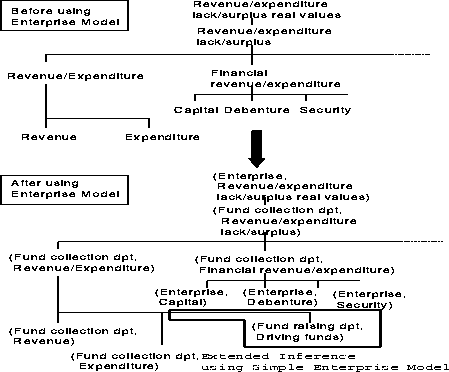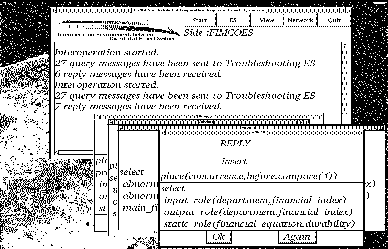
Table 1: Many Differences between the Results of FIMCOES and those of CPA



Deep Interoperation between
Previous: Implementing Deep Interoperation
After the enterprise diagnosis expert system FIMCOES (originator) finds many differences between its results(total action plan to be taken by an enterprise in bad financial states) and the human expert's (Certified Public Accountant) results for the same problem, as shown in Table 1, the originator gets into the interoperation environment and sends its models to the troubleshooting expert system (recipient) through the interoperation environment.

Table 1: Many Differences between the Results of FIMCOES
and those of CPA
After having received the message at the recipient, the correspondence values have been computed between two models from originator and the recipient, based on SS-based cooperation facilities. In this case, the primitive "compare" with pre-primitive "propagate" using physical/financial equations is unique between two models and thus it is chosen as good correspondence. Then it becomes different depending on whether or not "propagate" using device models exist in pre-primitive. The cooperation facilities make the difference into a reply message and send it back to the originator through communication facilities. In the originator receiving the reply message, communication facilities convert it into another message by changing knowledge roles in the message into other roles corresponded by a common domain ontology, as shown in Figure 6. After such a conversion, the expert system developer decides whether or not (s)he should modify the expert system implementation based on the converted message. Because it takes a great effort to make up an enterprise model that corresponds to a device model, the implementation of modification was suspended.

Figure 6: Converting an Original Reply Message from a Recipient
into another Reply Message Available to an Originator
Such interoperation processes have been completed three times, as shown in Figure 7. Although the third and fourth reply messages have been easy to implement and the the inference structure has been modified, the improvement of performance has not occurred. So when the originator developer gets back to the first reply message, the inference structure has been modified according to the first reply message, as shown in Figure 8, and a simple enterprise model has been constructed as shown in Figure 9. This model has six departments and fund-flow has been described instead of physical-media flow. For example, we see business fund flow between a fund raising department and a fund collection department. The two separate funds in the departments, called the driving fund and the revenue/expenditure fund, have a proportional relationship. Thus, when some value has been propagated to revenue/expenditure in financial equations, new sequent propagation to other financial indices comes up using this simple enterprise model, shown in Figure 10.

Figure 7: An Interoperation Processes between Two Diagnostic Expert Systems

Figure 8: Inference Structures of FIMCOES before/after Modification

Figure 9: Simple Enterprise Model with Business Fund Flow

Figure 10: Extended Inference using Simple Enterprise Model
Therefore the re-execution result has arisen, based on modified inference structure in FIMCOES. Table 2 shows us the comparison of results among CPA, FIMCOES before modification and FIMCOES after modification. We can see that FIMCOES after modification gets nearer to CPA than FIMCOES before modification. The interoperation environment implemented on Unix platform have been shown in Figure 11.

Table 2: The Comprison of Results among CPA and FIMCOESs before/after Modification

Figure 11: An Interoperation Environment Implemented on Unix Platformm



Deep Interoperation between
Previous: Implementing Deep Interoperation